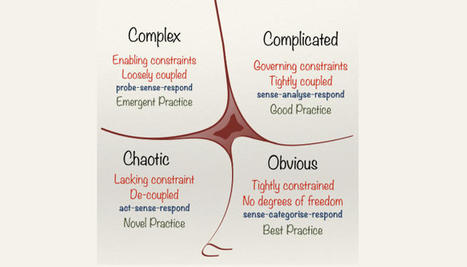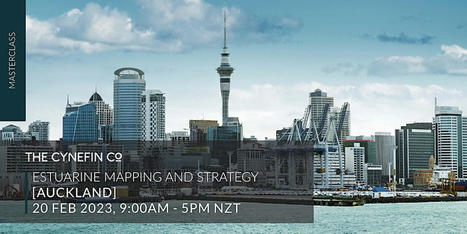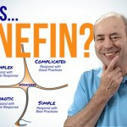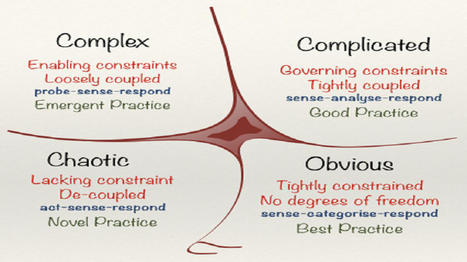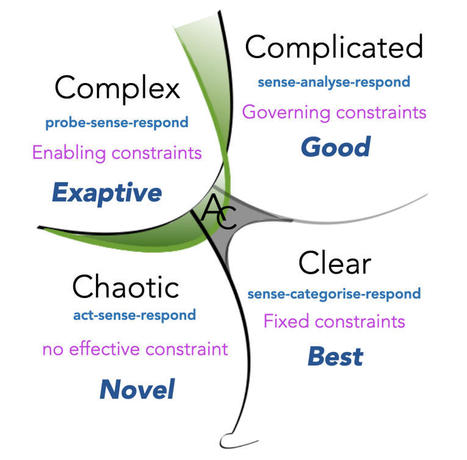 Your new post is loading...
 Your new post is loading...

|
Scooped by
F. Thunus
|
Why managers can assume making strategic assumptions supports effective decision-making...

|
Scooped by
F. Thunus
|
Mastering Project Uncertainty – A Systems Thinking Approach by Paul Cuypers offers a theoretical framework and practical models, tools, techniques, and guidelines to systematically minimize uncertainty, thereby increasing the chances of project success.

|
Scooped by
F. Thunus
|
This article asks the question: What is complexity? It then explores how we can manage this kind of problem.

|
Scooped by
F. Thunus
|
Ironically, decision makers often struggle to decide if they have chosen the right course of action for their businesses, or whether a decision that’s already...

|
Scooped by
F. Thunus
|
The popular notion that Cynefin can be applied in the software development domain to discuss the problems involved in writing software for money needs to include the profession of Systems Engineering.

|
Scooped by
F. Thunus
|
What are the most important life skills? How should we navigate work, survive challenges, and thrive in our relationships?

|
Scooped by
F. Thunus
|

|
Scooped by
F. Thunus
|
Eventbrite - The Cynefin Co presents Masterclass in Cynefin, Estuarine Mapping and Strategy - Monday, 20 February 2023 at Auckland, NZ. Find event and ticket information.

|
Scooped by
F. Thunus
|
The Cynefin Framework helps understand different types of problems and therefore what approach to take to problem-solving and decision-making...

|
Scooped by
F. Thunus
|
Dave Martin, Tony Ponton, and Kim Ballestrin explain that humans crave certainty, and we desperately want to be right the first time. They argue that trying to be “right” can lead us astray in highly complex environments.

|
Scooped by
F. Thunus
|
In this post, I want to share three things I do that you might find helpful in making sound decisions, technical decisions in particular.

|
Scooped by
F. Thunus
|
<img alt="" height="150" sizes="(max-width: 150px) 100vw, 150px" srcset="https://bjgplife.com/wp-content/uploads/ninja-forms/3/syed-ishaq-husain-profile-picture-1-150x150.jpg 150w, https://bjgplife.com/wp-content/uploads/ninja-forms/3/syed-ishaq-husain-profile-picture-1-300x300.jpg 300w, https://bjgplife.com/wp-content/uploads/ninja-forms/3/syed-ishaq-husain-profile-picture-1-24x24.jpg 24w, https://bjgplife.com/wp-content/uploads/ninja-forms/3/syed-ishaq-husain-profile-picture-1-48x48.jpg 48w, https://bjgplife.com/wp-content/uploads/ninja-forms/3/syed-ishaq-husain-profile-picture-1-96x96.jpg 96w, https://bjgplife.com/wp-content/uploads/ninja-forms/3/syed-ishaq-husain-profile-picture-1.jpg 331w" src="https://bjgplife.com/wp-content/uploads/ninja-forms/3/syed-ishaq-husain-profile-picture-1-150x150.jpg"; width="150" class="alignleft wp-image-13561 size-thumbnail">Syed Ishaq Husain is a GP Trainer at Grove Medical Centre, South East London, and an Executive MBA Candidate at Ashridge Executive Education, Hult International Business School. The culture of medicine, specifically as it pertains to hospital medicine, is stuck under the shoulder of a giant. William Osler brought the Newtonian paradigm of what was then cutting-edge science to the bedside of hospital medicine. Action = reaction, and all that follows from this, culminating in an entrenchment of linear thinking. Modern science has not been in thrall to the Newtonian paradigm for some time, where the inherent nature of uncertainty has been accepted. This is best illustrated by the Heisenberg principle.1 Introduced in 1927 by Werner Heisenberg, a physicist, the uncertainty principle states that the more precisely the position of a particle is determined, the less precisely it’s momentum can be predicted from initial conditions, and vice versa. It crystalises the inherent uncertainty of existence. What does this have to do with general practice? Making sense of the GP consultation can be hard. Ever since Balint2 described some of the psychological undercurrents of the GP consultations, models of the consultation have been put forward, each adding something new to the toolkit that GP’s can access, whether it is the concept of opportunistic health promotion,3 safety netting,4 or the decision to yield or not yield.5 When starting to learn about GP consultations many trainees expect consultations to conform to linear thinking, where cause, effect, and best practice management are clear, while trusted techniques help elucidate ideas, concerns, and expectations with a bit of opportunistic health promotion to boot. This may often relate to the influence of the Oslerian model of medical practice in hospital, personal experience, or the acceptance of media stereotypes of GP consultations. The reality is the consultations that leave their mark on us, that occupy our thoughts and challenge us, usually cannot be shoehorned into a linear model. Some defy easy explanation. Some have a myriad of multiple interacting components, which, with time, effort, and the power of continuity (which itself is only relatively recently being understood and appreciated) can be teased out. Some consultations have significant areas of uncertainty. Some are plain chaotic and it can be difficult to put a finger on why and leave the trainee (and often fully qualified GPs) questioning what they achieved in the consultation and frankly undeserved feelings of inadequacy. Such consultations can lead to significant unease in trainees, especially early in their training when informational uncertainty is high, and understanding and acceptance of the inherent uncertainty that is part of all existence is perhaps underdeveloped. A sense-making framework, applied to these consultations, can be helpful. Initially in retrospect as a reflective tool and, as time passes and familiarity with the framework grows, during the consultation itself. I suggest adapting the Cynefin framework,6,7 which takes its name from the Welsh word meaning ‘the place of your multiple belongings’. This was developed by Snowden in 2003 as sense-making framework in a business and organisational context, whose value lies in enhancing the ability to make sense of situations and improve decision-making capabilities. It helps break out of ineffective ways of thinking and helps look at difficult problems with new eyes. It consists of four domains (Figure 1). The use of the Cynefin framework in general practice has been suggested elsewhere.8 I suggest its particular strength is as an aid to facilitate reflection on consultations, make sense of them, develop a deeper understanding, and ultimately develop greater confidence — leading to better outcomes for patient and doctor. I have shared this approach with GP trainees and GP trainers who have found it a refreshing and novel approach. Once a GP can accept a scenario as known, knowable, complex, or chaotic, it then empowers them to use the most appropriate approach, without any feelings of inadequacy or guilt, which being unable to stick to a linear model can engender. It leads to a deeper understanding of the issues at play and an acceptance of the inherent nature of uncertainty, which are most to the fore in complex and chaotic scenarios. It adds another tool to the toolbox of the reflective GP, striving to improve their practice. References 1. Heisenberg W. The physical content of quantum kinematics and mechanics. In: Wheeler JA, Zurek WH. Eds. Quantum theory and measurement. Princeton, NJ: Princeton University Press, 2014. 2. Balint M. The doctor, his patient and the illness. London: Tavistock Publications, 1957. 3. Neighbour R. The inner consultation: how to develop an effective and intuitive consulting style. 2nd edn. Boca Raton, FL: CRC Press, 2005. 4. Stott NC, Davis RH. The exceptional potential in each primary care consultation. J R Coll Gen Pract 1979; 29(201): 201–205. 5. Mirza D. The FRAYED consultation model for doctors dealing with unreasonable demands from difficult patients. Better Doctor Training Ltd, 2016. 6. Kurtz CF, Snowden DJ. The new dynamics of strategy: sense-making in a complex and complicated world. IBM Systems Journal 2003; 42(3): 462–483. 7. Snowden DJ, Boone ME. A leader’s framework for decision making. Harv Bus Rev 2007; 85(11): 68–76, 149. 8. Gray B. The Cynefin framework: applying an understanding of complexity to medicine. J Prima Health Care 2017; 9(4): 258–261. Featured photo by Volodymyr Hryshchenko on Unsplash.

|
Scooped by
F. Thunus
|
Chaos, Cynefin, Complexity, Hexagonal Architecture, and Onions...
|

|
Scooped by
F. Thunus
|
THE CYNEFIN FRAMEWORK https://thecynefin.co/about-us/about-cynefin-framework/ Cynefin, pronounced kuh-nev-in, is a Welsh word that signifies the multiple, intertwined factors in our environment and our experience that influence us (how we think, interpret and act) in ways we can never fully...

|
Scooped by
F. Thunus
|

|
Scooped by
F. Thunus
|

|
Scooped by
F. Thunus
|

|
Scooped by
F. Thunus
|
The Lean Strategy System A new client company approached me a couple of months ago to support with its growth strategy. Having gone through years of turnarounds, downsizing, and divestitures, growth was lacking.

|
Scooped by
F. Thunus
|
Over the past year I have given a lot of consideration about the role of leaders in our organizations and how some of the core assumptions about leadership need to change. Surviving in broken systems and moving beyond them Many of our systems and institutions are broken. So how can we survive in these? The answer may be in adopting an ironic sense of humour, coupled with honesty and humility. Sensemaking through irony, and not falling into a state of anger, frustration, or apathy, can lead us toward envisaging new systems. When people in the roles of decision maker, expert, & resource controller — traditional bottlenecks for knowledge flow in organizations — adopt these perspectives then “distributed, iterative sense-making, decision-making, and action-taking” can be enabled. We have seen a “profound failure of ethical action” in dealing with the SARS-CoV-2 pandemic. As a society, we learned nothing from the influenza pandemic of 1918. We have learned little over the past three years. During this pandemic, many leading health and infectious disease experts have worked hard to promote misinformation leading to disinformation, in order to protect their institutions and disciplines, and not to protect people. This ethical crisis should be a wake-up call to build better educational, cultural, economic, and political structures. One approach could be strategic doing through agile sensemaking. As Cormac Russell noted, “Bureaucracies following an iron rule: those who wish to elevate, support, & practically resource community alternatives will always be junior/subordinate to those who want to feature their professional & institutional capacities above citizens and the communities they serve.” In broken institutions, loyalty is often strongest to the structure in place and this powerful antibody staves off any progressive ideas from outside. Progressive change in these environments has to be in the form of trojan mice developed in an ‘agile’ fashion, using Strategic Doing skills such as creating a short-term action plan in which everyone takes a small step and meeting every 30 days to review progress, adjust, and plan for the next 30 days. But to begin, those ‘ironic-sensemakers’ have to first build and protect safe spaces. The leadership lens It is time to dare to un-lead as Céline Schillinger advocates in her book of that title. “A movement toward more liberty, equality, and fraternity at work starts, as we have seen, with an individual distancing themselves from a dominant model — one inherited from the past, which has become restrictive and counterproductive — with others eventually electing to do the same.” As Father John Culkin wrote in 1967, “We become what we behold. We shape our tools and then our tools shape us.” Our organizational structures are just tools. They can be re-shaped. Leadership by example is what we need, and what all citizens should demand. As Bill Comeau implored for better public health practices, “We each have few times in our lifetime to truly lead by example. This is a unique opportunity for you to do something you will look back on and think ‘I did the right thing despite the pressures around me and maybe I helped a nurse from burning out or someone getting very sick’.” Complexity & Chaos There is a critical need to lead in complexity today. Making our networks smarter is one aspect of leadership in our digitally connected world and so is convening the best parts of our networks in order to address complex issues and make decisions. In crises, sometimes perfection is the enemy of the good, so having a diverse, knowledgeable, and experienced group of advisors becomes critical. Leadership today should be a temporary privilege and a permanent responsibility. Dmytro Yarmak shared his experience of leadership in chaos as he shifted from being an Agile IT coach to an officer in the Ukrainian Army. He explained how the Cynefin framework helped him understand the chaos of battle and complexity of war. This is a lesson for anyone in a leadership position today. This is agile sensemaking in action. “Knowing the Cynefin framework also helped me in another way. If you are in the Chaos domain there are no best practices as your context changes. So if something worked before there is simply no guarantee that it will work again or in your dynamically changing environment. So you should be really careful when someone insists on best practices. This helped me to calmly ignore suggestions that I felt would not work. And instead of an imaginary ‘silver bullet’, act and create new practices.” —Dmytro Yarmak Flipping leadership on its head Telling people what to do does not create value. Networks of trust are what create value at all levels for human society. If at any point a manager/executive/politician wonders why people are aimless, disengaged, or ineffective, then they should reflect upon self-determination theory which states that there are three universal human drivers — autonomy, competence, and relatedness. The historical role of management has been to reduce transaction costs in getting work done. A networked organization based on the compass of self-determination theory needs minimal management. It has the capability of sharing power between people and working together as the situation requires. It’s time to get rid of the great man theory of leadership and stop replacing CEOs and presidents while expecting different results — it’s the system, stupid. The pervasive authoritarian father needs to exit stage left, and quickly. Our optimal future is networked and feminine, despite the many authoritarians that still abound in organizations and institutions. One problem is how we perceive our optimum future. Often, the traditional political Right wants to go back to the Pre-modern (Institutional) Era — based on dogmatism, faith, & truth — while the traditional political Left wants to stay in the Modern (Market) Era — based on doubting, science, & facts. However, the best way ahead is toward a Meta-modern (Network) Era — based on seeking, knowledge, & combining. Leadership models from previous and current societal forms are insufficient for a meta-modern world, which offers a way out of our post-modern mess. Most of our leadership models and practices belong to yesterday. How can we listen to tomorrow if we have yet to clarify what belongs to yesterday? We don’t just need new maps that order the world in the same old ways. New vision is required. New ontologies reshape the map, and reshape us. So we should listen to the future. Whose voices do we hear? [Ursula] Le Guin writes, “which is farther from us, farther out of reach, more silent — the dead, or the unborn?” To listen, we must first be present. —Meta, Modern 2020-05-20 Related Postsimmunize for complexityEverything Connects

|
Scooped by
F. Thunus
|

|
Scooped by
F. Thunus
|
Read stories about Cynefin Framework on Medium. Discover smart, unique perspectives on Cynefin Framework and the topics that matter most to you like Agile, Complexity, Leadership, Cynefin, Scrum, Management, Problem Solving, Decision Making, and Complex Systems.

|
Scooped by
F. Thunus
|
Why are some organizations embracing new modern ways of approaching data, test automation, tools, planning and quality assurance - and some are not?

|
Scooped by
F. Thunus
|
Have you ever felt that the way you approach problems might be wrong but you cannot really explain why? The Cynefin framework is a tool to aid decision-making. It will help you find better strategies to get things done. This workshop provides an introduction to the 'sense-making' framework and will allow you to gain a deeper understanding of its different parts. You will also discover how Cynefin is connected to Agile People principles. In Collaboration with Agile People Learning Outcomes: Introduction to the Cynefin 'sense-making' framework Understand the different parts of the framework Understand the connection between Agile People principles and Cynefin Level: 1 - 2 Agile People Agile People helps organizations accelerate the agile transformation by spreading the values of customer collaboration, energizing people, learning organizations, and inspiring leadership. We do this by providing training, a global network of agile people professionals, coaching, and consulting services to create better organizations, and regularly run training, workshops, professional services, conferences, meetups, and speakers for increased agility in a complex world. We are passionate about creating motivation and engagement using an agile mindset and practices/tools that make people happy and perform towards the company vision. We strive to create environments that will foster learning organizations to innovate and continuously improve when the only remaining competitive advantage is to learn faster than competitors. Since the launch in 2012, our network of facilitators and coaches has grown steadily, and today we are represented in almost every corner of the world.” Email: [email protected] Phone: +46767711029 Website: agilepeople.com/ LinkedIn: https://linkedin.com/company/agilepeoplecom/ Return to listing

|
Scooped by
F. Thunus
|
Make sense of different situations to choose an appropriate response.

|
Scooped by
F. Thunus
|
|
 Your new post is loading...
Your new post is loading...
 Your new post is loading...
Your new post is loading...









